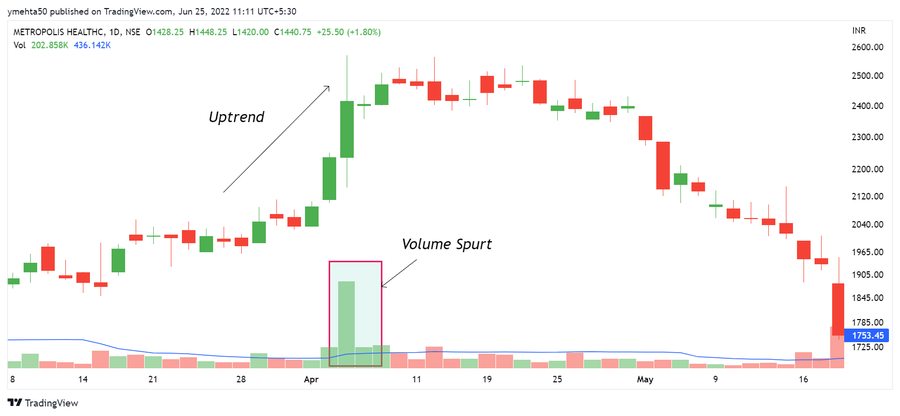What is this Volume Climax?
You would have seen some kind of spurt in volume in a day after a up/downtrend. Here, we don't consider any day in which there is corporate action or quarterly result.
Let's see some chart:
Below Chart is of #Metropolis when volume spurt occurred.
Now one to observe in Metropolis chart is after that volume spurt candle, the uptrend had paused.
This means at this candle smart money had offloaded the stock and retailers bought it. Hence stock went in the downtrend and Metropolis went down by 20%.
So this volume spurt on non corporate action day can bring pause in the existing trend and it can start the opposite trend.
In the above example, when price was in uptrend, it went in downtrend and vice versa is also applicable.
In below example, #IOLCP was in downtrend when volume got spiked. After that, the price moved up by 20% in a few days.
Seems easy right?
But there are some rules that I have created for my own trading. Let's see that now.
So one will ask how much volume spike should be there?
There is no mathematical definition for this. If you open the chart, just see that the volume is highest in the normal range of candle (can consider last 100 candles).
Now where to look at Volume Spike?
Volume Spike should happen after a downtrend/uptrend to catch the reversal trade opposite direction.
Which Time Frame?
Use Daily/Weekly/Monthly but don't use it in #Intraday.
What's the rule for trading?
⚡️After spotting the candle in which Volume Spike is there, mark high and low of that candle as it is very important.
⚡️As we are discussing strategy for buy, we will wait for the price in the next few days to close above the high of that candle
⚡️Once the price closes above the high, buy that stock and keep stoploss a few points below the low of the candle in which the spike is there.
⚡️Sometimes candle will be big and sometimes it will be small, so better risk 2-3% of the total capital in each trade.
⚡️Keep Risk:Reward of atleast 1:2. So let's say risk in stoploss is 10 points, then reward/target has to be more than 20 points.
⚡️I also use 10-20% target for short term and 40-50% target in positional trade. You can use this rule as well.
⚡️As we are taking reversal trade, hence no need for trailing stoploss. Exit if your target is hit or trail aggressively.
⚡️If you see Volume Climax setup at support/resistance, then it is the best trade to take in swing/positional. Never miss such a trade.
Now let's see an example in which I personally took the trade based on Volume Climax and also it was shared on Twitter.
#DMART Weekly Time Frame formed Volume Climax Pattern and after breakout stock moved up by 100%.
Risk was hardly 20% in this.
Same thing can be used in Daily/Monthly time frame considering your trading style.
Best part of taking reversal trade is the risk on the basis of Stoploss is minimal.
Moreover, I use it only for buying as I don't prefer shortselling any stock.
You can check how this setup works on the stock and also comment about the returns that you would have made based on this.
Just a reminder that it is not a holy grail strategy, so follow the trading plan properly and exit if stoploss gets hit.
Expecting that this strategy will be copied by YouTubers/Trainers after seeing the performance and they will twist it a bit and sell it.
But it doesn't matter. The foundation of the strategy is important it is shared here for free.
That's all about the strategy.
If you find this strategy useful, then do give us a Thumbs Up 👍 by Liking ❤️and Retweeting 🔄the first tweet.
Thanks for Reading.
https://t.co/MgKNnAKEDH




